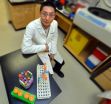(Press-News.org) (Boston) – A new study involving researchers from the Boston University School of Medicine (BUSM) has identified barriers that clinicians face in correctly ordering appropriate laboratory tests and highlights some solutions that may simplify this process and improve patient outcomes. The study, published in the March 2013 issue of the Journal of General Internal Medicine, was led by Elissa Passiment, EdM, of the American Society for Clinical Laboratory Science and James L. Meisel, MD, associate professor of medicine at BUSM.
Passiment, Meisel and colleagues identified a number of significant problems, including the multiplicity of names and abbreviations used for a laboratory test, as well as the complexity and lack of standardized test nomenclature. As an example, they note that the commonly ordered laboratory test "brain naturetic peptide (BNP)" has a number of other names and abbreviations and looks and sounds similar to another commonly ordered test, "basic metabolic panel (BMP)." The incorrect ordering of such tests can lead to increased medical cost, physician frustration, and at worst, delayed diagnosis and treatment. This has been perceived as having a direct impact on patient safety. The AHRQ Patient Safety Network (PSNet) cited the article in the January "What's New" feature of patient safety literature, news and other resources.
"We found that attempts to standardize or establish a naming convention for laboratory tests were either short-lived or did not yield systems that were clinician or patient friendly," said Passiment.
The researchers suggest that certain technologies and programs that are familiar to many people could clarify some of the issues highlighted in this study. For example, search engines such as GOOGLE and BING help guide users to the most appropriate search results. If similar technology was employed in ordering laboratory tests, it could help guide clinicians towards identifying the appropriate tests, as well as conditions that would warrant the ordering of specific tests.
"Clinical laboratory tests lose their efficacy when clinicians are unable to quickly obtain accurate test results in a timely manner," said Meisel. "The goal is to have a system that clinicians find convenient, flexible and fast to best ensure the correct ordering and interpretation of laboratory tests."
The issues highlighted in this study will become more relevant as clinicians depend increasingly on electronic systems. "In the end these systems should be set up to mimic – as much as possible - the type of interaction a clinician would expect with a knowledgeable and helpful human being," added Meisel.
###
This publication is an outcome of the Clinical Laboratory Integration into Healthcare Collaborative (CLIHC)TM, a workgroup established by the Centers for Disease Control and Prevention (CDC's) Division of Laboratory Science and Standards.
MANHATTAN -- A Kansas State University research team has found that despite humans increasing nitrogen production through industrialization, nitrogen availability in many ecosystems has remained steady for the past 500 years. Their work appears in the journal Nature.
"People have been really interested in nitrogen in current times because it's a major pollutant," said Kendra McLauchlan, assistant professor of geography and director of the university's Paleoenvironmental Laboratory. "Humans are producing a lot more nitrogen than in the past for use as crop fertilizer, ...
Philadelphia, PA, March 21, 2013 – The April issue of Translational Research examines the progress and outlook of gene therapy research, with a specific focus on the clinical applicability of gene therapy today. Research articles included in the special issue highlight current studies that, after decades of trial and error, may provide evidence for a clear path of treatment and cure for many diseases. There are more than 1,800 genetic disorders known in humans, and only a small fraction of these can be treated and even fewer cured. Some of these disorders are exceedingly ...
University of Colorado Boulder astronomers targeting one of the brightest quasars glowing in the universe some 11 billion years ago say "sideline quasars" likely teamed up with it to heat abundant helium gas billions of years ago, preventing small galaxy formation.
CU-Boulder Professor Michael Shull and Research Associate David Syphers used the Hubble Space Telescope to look at the quasar -- the brilliant core of an active galaxy that acted as a "lighthouse" for the observations -- to better understand the conditions of the early universe. The scientists studied gaseous ...
Once rhesus monkeys learn to associate a picture with a reward, the reward by itself becomes enough to alter the activity in the monkeys' visual cortex. This finding was made by neurophysiologists Wim Vanduffel and John Arsenault (KU Leuven and Harvard Medical School) and American colleagues using functional brain scans and was published recently in the leading journal Neuron.
Our visual perception is not determined solely by retinal activity. Other factors also influence the processing of visual signals in the brain. "Selective attention is one such factor," says Professor ...
New Rochelle, NY, March 21, 2013—A new study of patterns of brain communication in toddlers with autism shows evidence of aberrant neural communication even at this relatively early stage of brain development. The results are presented in an article in Brain Connectivity, a bimonthly peer-reviewed journal from Mary Ann Liebert, Inc., publishers. The article is available free on the Brain Connectivity website at http://www.liebertpub.com/brain.
A team of researchers from The Netherlands (University Medical Center Utrecht and Utrecht University, Radboud University Nijmegen ...
A national survey of health professionals showed that drug shortages are taking a heavy toll on cancer patients, forcing treatment changes and delays that for some patients meant worse outcomes, more therapy-related complications and higher costs. St. Jude Children's Research Hospital investigators played an important role in the study.
The survey queried oncology pharmacists and others involved in managing cancer drug shortages for academic medical centers, community hospitals and other cancer treatment facilities nationwide. Of the 243 individuals who completed the ...
AUGUSTA, Ga. – Food and environment can chemically alter your gene function and scientists have identified a gene that is consistently altered in obesity.
The gene LY86 was among a group of 100 genes identified as likely contributors to obesity through genome-wide association studies comparing the DNA of thousands of obese and lean individuals, said Dr. Shaoyong Su, genetic epidemiologist at the Medical College of Georgia at Georgia Regents University.
Su looked at progressively larger groups of obese versus lean individuals and found LY86 consistently and highly chemically ...
UT Dallas researchers are developing a new low-light imaging method that could improve a number of scientific applications, including the microscopic imaging of single molecules in cancer research.
Electrical engineering professor Dr. Raimund Ober and his team recently published their findings in the journal Nature Methods. In the journal, they describe a method which minimizes the deterioration of images that can occur with conventional imaging approaches.
"Any image you take of an object is translated by the camera into pixels with added electronic noise," Ober said. ...
ITHACA, N.Y. — With a dizzying number of ties in our social networks – that your Aunt Alice is a neighbor of Muhammad who is married to Natasha who is your wife's boss – it's a wonder we remember any of it. How do we keep track of the complexity? We cheat, says a Cornell University sociologist in Scientific Reports (March 21), a publication of Nature.
Study: http://www.nature.com/srep/2013/130321/srep01513/full/srep01513.html
Humans keep track of social information not by rote memorization but with simplifying rules, as you might remember a number sequence that always ...
Researchers at Moffitt Cancer Center and colleagues in Canada have published study results focused on black women younger than 50, a population disproportionately afflicted with and dying from early-onset breast cancer compared to their white counterparts. The research published in the Jan. 16 issue of The Breast Journal.
Early-onset breast cancer has been associated with mutations in the BRCA1 and BRCA2 genes. These breast cancer predisposing genes were discovered almost 20 years ago and confer a lifetime risk of breast cancer of 60 to 70 percent, as well as a much higher ...


